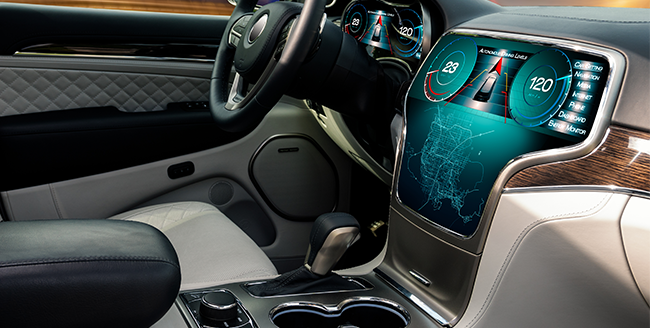New Trends in Automotive Interior Lubrication
Automotive interior design is one of the most distinct ways OEMs can distinguish themselves from the competition. We sat down with our automotive experts to discuss new trends affecting developments in automotive interiors and the role lubricants play in enabling them.

A: Erik Reis - Senior Manager of US Sales & Automotive Industry Manager
Automotive is moving toward a more electrified future, and this involves utilizing an electric drivetrain as opposed to the more traditionally known internal combustion engine. Engines create vibration and noise which masks any other potential noises that may be occurring in the interior of a vehicle. Once an engine is replaced by an electric drivetrain, which is a much quieter technology, annoying buzz, squeaks, and rattles become much more apparent. This can have a direct effect on the perception of quality leading to an erosion of brand image.
Properly selected lubricants can greatly mitigate, if not eliminate, buzz, squeak, and rattle noises in the interior of a vehicle leading to greater customer satisfaction and perceived quality. Tolerances of mating parts that are a bit too large, or components that rub and slide against one another due to road vibration can all create noise. Utilizing an appropriate grease designed for the interior of a vehicle, and the sub-components involved, will reduce surface friction and provide a damping characteristic that allows components to interact with each other noise free. Not only do these lubricants eliminate noise, but they create an experience where the customer feels, through interaction with these components, a product that emanates quality.
A: Jeff Wheeler- Engineering Manager, Automotive Electrical
We all are accustomed to our dashboards loaded with dials, knobs and mechanical buttons. As the interior of vehicles transition to becoming more of an experience, particularly with the acceleration of electrification, many evolving technologies are taking their place. Touch screens, voice command and other smart user interfaces will become commonplace. Advanced Driver Assistance Systems, infotainment, communication, and telematics are becoming more important. Connectivity and human-machine-interface systems will begin to dominate product features. The customer experience will become one of the most important elements consumers consider when making decisions on purchases. Some of the features customers will be looking for will include access to wireless communication, touch interfaces, internet and cloud connectivity, and even superior lighting and sound systems.
The common denominator for all these emerging technologies will be how they communicate, function, and receive power. The connectors that provide the interface between all these technologies will continue to have the same common problems that all connectors experience – fretting corrosion, insertion and mating force issues, and keeping water, salt and humidity out. These connectors require additional protection to avoid these common causes of electrical failure—that’s where Nye’s connector lubricants come in. Our specially formulated products help mitigate or even eliminate these issues. These problems are not limited to traditional connectors - we are also seeing these concerns with FAKRAs, ethernet and all types of USB connectors.
All this will be further complicated as autonomous functions and shared services become more commonplace. Failures in critical systems will not only be an annoyance but could also cause serious safety issues. Nye’s connector lubricants continue to be a prominent player in protecting the consumer and allow the OEMs to provide superior reliability, robustness and an immersed customer experience.
A: Brian Gira – Engineering Manager, Automotive Interiors
Complaints about strong interior odors, even with the same vehicle on a global platform, are collected as much as 18 times in Asia as often when compared to customer feedback in other regions. With new Vehicle Interior Air Quality (VIAQ) regulations slated to be finalized and in effect by early 2026, interior component manufacturers need to focus on these items in order to win over Asian consumers.
Additionally, even outside of the Asia Pacific region consumers are beginning to understand that the classic “new car smell” may pose health concerns and is a result of off-gassing from volatile organic compounds (VOCs) used in vehicle assembly.
Along with challenges surrounding sustainability, lightweighting, and supporting electrification pushes, minimizing interior VOCs is quite a challenge for Automotive OEMs. FUCHS and Nye Lubricants have been developing new formulations as well as testing our existing products to ensure they comply with these stringent requirements. The BMW VDA 270 odor test has quickly become the global standard for odor ratings and we have been working with the top testing labs to certify our low odor products to be equal to or better than the industry standard.
As an example, Fluorocarbon Gel 880 is a great low odor VDA 270-compliant grease for interior hardware components like sunroof slides, seat mechanisms, window regulators, and lock mechanisms. It can be used in plastic on plastic or plastic on metal applications.
A: Dr. Jennifer Frias - Scientist Group Leader of Rheology, OEM Specialty Greases & Ultrachem
A Motion Control lubricant used in Automotive interior applications, such as a radio knob or sun visor, must provide the same actuation force regardless of temperature to give the user the same quality feel. The temperatures observed in the automotive industry range from -40 to 120 °C. Nye’s rheology team has developed a new custom test method on a rotational rheometer to measure the lubricant’s viscous consistency at the extreme ends of this temperature range. The custom rheological test requires minimal sample material and can measure the shear response at different strains to simulate any customer’s application. The result is a viscosity ratio where the ideal value of 1.0 represents no change in performance across the desired temperature range. This highly customizable test allows the R&D team to screen lubricants faster to develop our next-generation Automotive Motion Control lubricants.

